
Welcome to the nutritional potassium content in 10 different types of kale, ranging from 491.00 mg to 178.00 mg per 100g. The basic type of kale is Kale, raw, where the amount of potassium in 100g is 491.00 mg. 491.00 mg of potassium per 100g, from Kale, raw corresponds to 10% of the potassium RDA. For a typical serving size of 1.000 cup 1" pieces, loosely packed (or 16.00 g) the amount of Potassium is 78.56 mg. This corresponds to an RDA percentage of 2%.
The percentage of the recommended daily allowance (RDA) for potassium is based on a 4700 mg RDA level for a mature adult.
Top five kale products high in potassium
Below is a summary list for the top five kale items ranked by the amount or level of potassium in 100g.
1. Kale, raw : 491.00mg (10%RDA)
2. Kale, scotch, raw : 450.00mg (10%RDA)
3. Kale, frozen, unprepared : 333.00mg (7%RDA)
4. Kale, frozen, cooked, boiled, drained, without salt : 321.00mg (7%RDA)
5. Kale, frozen, cooked, boiled, drained, with salt : 321.00mg (7%RDA)
Following on from the five top kale items or products containing potassium we have a more comprehensive break down of Kale, raw, and the highest item containing potassium which is Kale, raw. We also give a comparison of average values, median values and lowest values along with a comparison with other food groups and assess the effects of storage and preparation on the 10 types of kale.
At the bottom of the page is the full list for the 10 different types of kale based on the content in different servings in grams and oz (and other serving sizes), providing a comprehensive analysis of the potassium content in kale.
Kale, raw - Nutritional Content and Chart
The full nutrition content, RDA percentages and levels for Kale, raw should be considered along with the potassium content. This food profile is part of our list of food and drinks under the general group Vegetables and Vegetable Products.Other important and potassium related nutrients are Energy, Sodium, Protein, Total Fat and Carbohydrate. For this 100g serving in your diet, the amount of Energy is 49.00 kcal (2% RDA), the amount of Sodium is 38.00 mg (2% RDA), the amount of Protein is 4.28 g (8% RDA), the amount of Total Fat is 0.93 g (1% RDA) and the amount of Carbohydrate is 8.75 g (7% RDA). The nutritional content and facts for 100g, which includes Energy, Sodium, Protein, Total Fat and Carbohydrate is shown in the RDA chart below as percentages of the recommended daily allowance along with the potassium levels in kale.
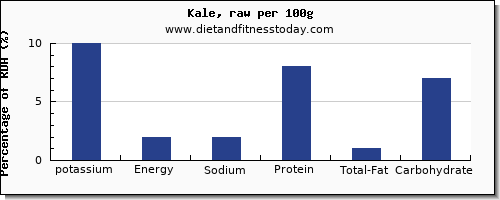
Our proprietary nutritional density score gives a nutritional value out of 100 based on 9 different vitamins, minerals and macro nutrients. Kale, raw has a nutritional value score of 44.00 out of 100.Comparing the potassium content and the nutritional density in 100g for Kale, raw; We class this as a medium to low potassium content item.In terms of overall nutritional value we class this as an item with a high nutritional density value.
Amount of potassium per 100 Calories
100 calories of kale, raw is a serving size of 0 g, and the amount of Potassium is 0 mg (0% RDA). Other important and related nutrients and macronutrients such as Protein, in 100 Calories are as follows; Energy 0 kcal (0% RDA), Sodium 0 mg (0% RDA), Protein 0 g (0% RDA), Total Fat 0 g (0% RDA), Carbohydrate 0 g (0% RDA). This is shown in the potassium RDA percentage chart below, based on 100 Calories, along with the other important nutrients and macro nutrients.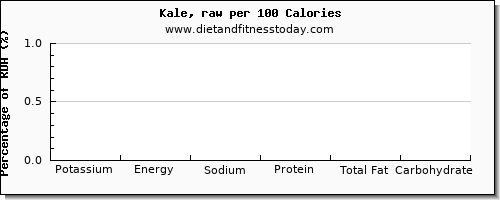
Content per Typical Serving Size 1.000 cup 1" pieces, loosely packed (or 16.00 g)
For the food Kale, raw the typical serving size is 1.000 cup 1" pieces, loosely packed (or 16.00 g) which contains 78.56 mg of Potassium. The potassium percentage of the recommended daily value for this serving is 2 %.To give 100% of the RDA, 50.0 servings of the typical serving size 1.000 cup 1" pieces, loosely packed (or 16.00 g) give the complete RDA. In terms of the gram weight and total content for this serving the Energy content is 7.84 kcal, the Sodium content is 6.08 mg, the Protein content is 0.68 g, the Total Fat content is 0.15 g and the Carbohydrate content is 1.4 g. The percentages are shown below in the potassium chart, for the typical serving of potassium and the related and important nutritional values.
Macronutrients in Kale, raw
The amount of protein, fat and carbs from this food described above is measured in grams per 100g and grams in a typical serving size (in this case 1.000 cup 1" pieces, loosely packed or 16.00 g), although it is also useful to give the number of calories from protein, fat and carbohydrate which are the most important macronutrients. For this serving in your diet here are the macronutrient calories. From protein the number of calories is 1.7 (kcal).The total calories from carbohydrate is 5.0 (kcal).
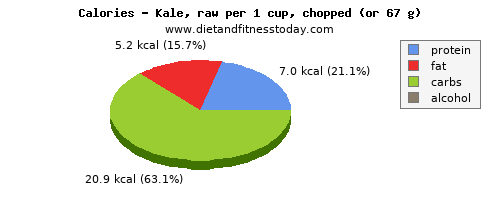
Milligrams of potassium in kale (per 100g)
This list of 10 types of kale, is brought to you by www.dietandfitnesstoday.com and ranges from Kale, raw through to Vegetable smoothie, NAKED JUICE, KALE BLAZER where all food items are ranked by the content or amount per 100g. The nutritional potassium content can be scaled by the amount in grams, oz or typical serving sizes. Simply click on a food item or beverage from the list at the bottom of the page to give a full dietary nutritional breakdown to answer the question how much potassium in kale.
The list below gives the total potassium content in the 10 items from the general description 'kale' each of which show the potassium amount as well as Energy, Sodium, Protein, Total Fat and Carbohydrate. Below, is the top 10 food items shown in the potassium chart. This gives a quick and easy dietary comparison for the different items, where each item is listed at the bottom of the page with a nutritional summary.
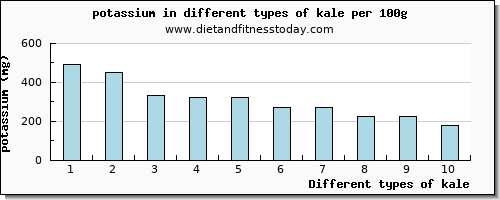
The corresponding nutritional value for kale based on our density score out of 100 (ranked by the amount of potassium per 100g) is shown in the below nutritional density chart. 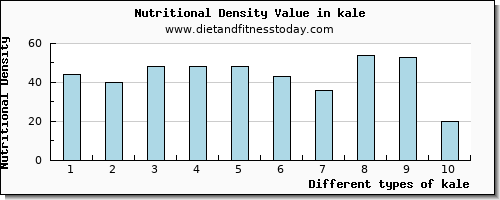
The corresponding Calories for kale ranked by the amount of potassium per 100g is shown below in the kale calories chart. 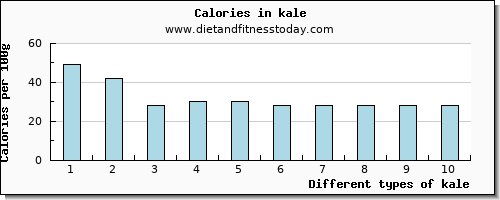
RDA for potassium
The recommended daily allowance for potassium is actually an adequate intake. The RDA for all of the nutrition data listed on this page is for 4.7g per day which is for males and females between the ages of 14 and 70+. For children between the ages of 1-3 years it is 3.0g, for children between the ages of 4-8 years it is 3.8g, and for children between the ages of 9-13 years it is 4.5g. For women during lactation between the ages of 19-50 years the level is slightly higher at 5.1g.
Effect of Preparation and Storage on potassium
The level of potassium can be affected by the method of storage for example canned or frozen and also by the method of preparation for example either raw, cooked or fried. The total number of frozen food items is 3. The highest amount of potassium from the 3 frozen items is in Kale, frozen, unprepared where the potassium content is 333.00 mg per 100g. The total food items which are raw is 2 items. The highest amount of potassium from the 2 raw items is in Kale, raw where the content is 491.00 mg per 100g. The number of food items which are cooked are 6 items. The highest amount of potassium from the 6 cooked items is in Kale, frozen, cooked, boiled, drained, without salt where the amount is 321.00 mg per 100g. Comparing raw and cooked kale shows that cooking can change the levels of potassium by 170 mg in a 100g serving.Average Content for kale
The average (or more correctly the arithmetic mean) amount of potassium contained in 100g of kale, based on the list below of 10 different items under the general description of kale, is 309.80 mg of potassium. This average value corresponds to 6.59 % of the recommended dietary allowance (or RDA) in your diet. The averages for the different nutrients are as follows; the average amount of Energy is 31.90 kcal, the average amount of Sodium is 101.00 mg, the average amount of Protein is 2.38 g, the average amount of Total Fat is 0.47 g and the average amount of Carbohydrate is g.Median Amount
The median value of Potassium is found in Kale, frozen, cooked, boiled, drained, with salt which in 100g contains 321.00 mg of Potassium. This corresponds to 7 % of the recommended daily allowance. For this serving the amount of Energy is 30.00 kcal, the amount of Sodium is 251.00 mg, the amount of Protein is 2.84 g, the amount of Total Fat is 0.49 g and the amount of Carbohydrate is 5.23 g.Highest potassium Content per 100g

Using the list below for the 10 different kale nutrition entries in our database, the highest amount of potassium is found in Kale, raw which contains 491.00 mg of potassium per 100g. The associated percentage of RDA is 10 %. For this 100g serving the Energy content is 49.00 kcal, the Sodium content is 38.00 mg, the Protein content is 4.28 g, the Total Fat content is 0.93 g, the Carbohydrate content is 8.75 g. 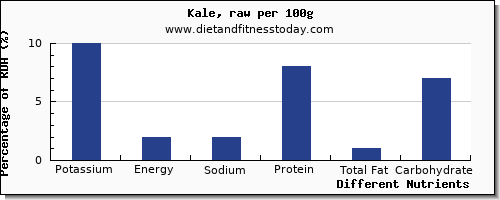
The lowest amount of potassium in 100g is in Vegetable smoothie, NAKED JUICE, KALE BLAZER which contains 178.00 mg. This gives as percentage of the recommended daily allowance 4 % of the RDA. For this 100g serving the amount of Energy is 28.00 kcal, the amount of Sodium is 13.00 mg, the amount of Protein is 0.80 g, the amount of Total Fat is 0.07 g, the amount of Carbohydrate is 7.00 g.
The difference between the highest and lowest values gives a potassium range of 313 mg per 100g. The range for the other nutrients are as follows; 21 kcal for Energy, 25 mg for Sodium, 3.48 g for Protein, 0.86 g for Total Fat, 0 g for Carbohydrate.
Highest Amount of potassium per Serving
Please remember that the above gives an accurate value in 100g for high potassium foods in your diet. For example 100g of Kale, raw contains 491.00 mg of potassium. However, there are other factors to consider when you are assessing your nutritional requirements. You should also take into account portion sizes when you are considering the potassium nutritional content.
The food with the highest potassium content per typical serving is Vegetable smoothie, NAKED JUICE, KALE BLAZER which contains 477.04 mg in 1.000 cup (or 268.00 g). The percentage of the recommended daily value for this serving is 10 %. For this serving the Energy content is 75.04 kcal, the Sodium content is 34.84 mg, the Protein content is 2.14 g, the Total Fat content is 0.19 g and the Carbohydrate content is 18.76 g.
Nutritional Information Summary
From the list below you can find a full nutrition facts breakdown for all foods containing potassium which can be scaled for different servings and quantities. We have also sorted our complete nutritional information and vitamin database of over 7000 foods, to give a list of potassium rich foods.
| |||||||||||||||||||||||||||||||||||||||||||||||||||||||||||||||||||||||||||||||||||||||||||||||||||||||||||||||||||||||||||||||||||||||||||||||||||||||||||||||||||||||||||||||||||||||||||||||||||||||||||||||||||||||||||||||||||||||||||||||||||||||||||||||||||||||||||||||||||||||||||||||||||||||||||||||||||||||||||||||||||||||||||||||||||||||||||||||||||||||||||||||||||||||||||||||||||||||||||||||||||||||||||||||||||||||||||||||||||||||||||||||||||||||||||||||||||||||||||||||||